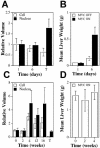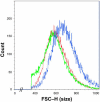Developmental context determines latency of MYC-induced tumorigenesis
- PMID: 15455033
- PMCID: PMC519000
- DOI: 10.1371/journal.pbio.0020332
Developmental context determines latency of MYC-induced tumorigenesis
Abstract
One of the enigmas in tumor biology is that different types of cancers are prevalent in different age groups. One possible explanation is that the ability of a specific oncogene to cause tumorigenesis in a particular cell type depends on epigenetic parameters such as the developmental context. To address this hypothesis, we have used the tetracycline regulatory system to generate transgenic mice in which the expression of a c-MYC human transgene can be conditionally regulated in murine hepatocytes. MYC's ability to induce tumorigenesis was dependent upon developmental context. In embryonic and neonatal mice, MYC overexpression in the liver induced marked cell proliferation and immediate onset of neoplasia. In contrast, in adult mice MYC overexpression induced cell growth and DNA replication without mitotic cell division, and mice succumbed to neoplasia only after a prolonged latency. In adult hepatocytes, MYC activation failed to induce cell division, which was at least in part mediated through the activation of p53. Surprisingly, apoptosis is not a barrier to MYC inducing tumorigenesis. The ability of oncogenes to induce tumorigenesis may be generally restrained by developmentally specific mechanisms. Adult somatic cells have evolved mechanisms to prevent individual oncogenes from initiating cellular growth, DNA replication, and mitotic cellular division alone, thereby preventing any single genetic event from inducing tumorigenesis.
Conflict of interest statement
The authors have declared that no conflicts of interest exist.
Figures











References
-
- Abou-Elella A, Gramlich T, Fritsch C, Gansler T. c-myc amplification in hepatocellular carcinoma predicts unfavorable prognosis. Mod Pathol. 1996;9:95–98. - PubMed
-
- Adams JM, Harris AW, Pinkert CA, Corcoran LM, Alexander WS, et al. The c-myc oncogene driven by immunoglobulin enhancers induces lymphoid malignancy in transgenic mice. Nature. 1985;318:533–538. - PubMed
-
- Artandi SE, Chang S, Lee SL, Alson S, Gottlieb GJ, et al. Telomere dysfunction promotes non-reciprocal translocations and epithelial cancers in mice. Nature. 2000;406:641–645. - PubMed
-
- Blyth K, Stewart M, Bell M, James C, Evan G, et al. Sensitivity to myc-induced apoptosis is retained in spontaneous and transplanted lymphomas of CD2-mycER mice. Oncogene. 2000;19:773–782. - PubMed
-
- Boige V, Laurent-Puig P, Fouchet P, Flejou JF, Monges G, et al. Concerted nonsyntenic allelic losses in hyperploid hepatocellular carcinoma as determined by a high-resolution allelotype. Cancer Res. 1997;57:1986–1990. - PubMed
Publication types
MeSH terms
Substances
Associated data
- Actions
- Actions
- Actions
- Actions
- Actions
Grants and funding
LinkOut - more resources
Full Text Sources
Molecular Biology Databases
Research Materials
Miscellaneous

